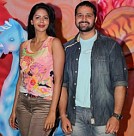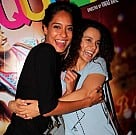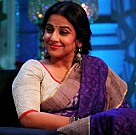''THE VENKAT PRABHU – SURIYA PROJECT WILL BE HANDLED IN A REALLY PROFESSIONAL MANNER''
Interview Team : Kaushik L M; VenkatEditors Praveen and Srikanth have to be among the most prolific professionals in the industry. Starting their journey with Chennai 28 and going strong ever since, they have worked on many successful and critically acclaimed films. Their partnership with director Venkat Prabhu has been a sure-shot since Day 1.
One half of the duo, the enthusiastic Praveen KL takes some time out from his super-busy schedule for this conversation with Behindwoods.
PHOTOS & STILLS - GALLERY
Talk us through your initiation to the industry
When I was 17, I wanted a bio-tech admission. But I didn’t get it as the seats were full. In the intermittent one year gap, I didn’t want to be idle and learnt editing at the studio.
I didn’t have any formal training. I didn’t wish to be here in fact. My father and lots of other people from the family were already from cinema.
My father used to work for ETV, the Telugu satellite channel. For about 4 months, I interned there and then I was also offered a job. I worked there for 4 years.
Later, I worked with Balu Mahendra Sir on ‘Kadhai Neram’, a TV series. For 1.5 years, I worked with him.
I then went to Singapore for a 2 months’ job assignment. I did it for a friend and then continued there.
Life was going on like that, with no connect to cinema. Then I met Venkat Prabhu in 2006 through a common friend. He said that he was about to do a film and asked me if I wanted to edit. I was well-settled in Singapore by then, and just asked him for a script. After a couple of months, I got the script and tickets. I took up Chennai 28 as a jolly 2 months’ holiday assignment.
I returned to Singapore after Chennai 28 and worked as a freelancer for Discovery and other channels.
Then one day, Venkat said that he was doing Saroja. I was wondering “cinema again?”
Till movies like Saroja and Kandasamy, my edits used to happen 3 days here, 3 days there and even in airports’ lounges.
But after Saroja got a state award, I became more serious and thought “OK, even I have some serious skill on hand” and settled here. That’s how it all started. Now we are nearing 50 films, including 1 in Telugu, 2 in Malayalam and 1 Singaporean film too.
Currently we are involved in films like Kaaviya Thalaivan, Aranmanai, Koothara, Kaali, Sigaram Thodu, Vada Curry and the Suriya Venkat Prabhu project. We have about 12 films in hand.
Till movies like Saroja and Kandasamy, my edits used to happen 3 days here, 3 days there and even in airports’ lounges.
The people you assisted?
I didn’t assist anyone but Balu Mahendra Sir thought me a lot. In fact I unlearned a lot. He teaches only those whom he really likes. It’s tough for him to start teaching someone. Vetrimaaran, Madha Yaanai Koottam’s director Vikram Sugumaran and I were among the chosen few. He took personal interest in us.
Were you involved in the pre-digital editing era?
I worked casually with my uncles on weekends, in that era too. I started off as an analog editor and I have seen the transitions in technology. It was good training for me and every editor should pass through that grind.
With tapes and other analog technologies, it took a lot of time and edits were totally linear. With digital, it has become totally non-linear.
After digital camera technologies, has your job become tougher due to all the increase in footage and options for each shot? Has work load increased?
Digital has totally changed the job of an editor. Our extent of work has increased and we are involved in many processes. The time load has increased.
As an editor, am always ready to work with many shot options. But work load has really increased.
What’s your style of working?
Right from the time we hear a film’s script, we start thinking about the edits. That’s how it happened for Chennai 28 and since then this pattern has stuck on. All directors ask for reference before going for shoots. Such planning and reference videos are always good.
Directors are in fact happy when we show them reference videos before shoots. That’s why we are in demand I guess (laughs)
Your edits comprise a lot of effects and stylish cuts. Is that your signature?
Nowadays effects are becoming synonymous with editing, fortunately or unfortunately. People ask for the ‘Goa style’ from me and they like such effects and flashy visuals.
We upped the style for Mankatha too. A Thala film was a big jump for us - from Goa to Ajith. After Chennai 28 itself, we were supposed to do an Ajith film. That was not Mankatha but a different film. Ajith sir was ready, story discussions happened but it didn’t work out that time. Then Mankatha happened.
A Thala film was a big jump for us
Which tool do you use?
Avid is used predominantly, FCP isn’t used that much while other tools like Aftereffects and Photoshop are also used.
Do all your film edits happen at your office or do you move out for big films?
It depends on the project. Sometimes, a part of the edits happen at our studio and at the production house’s setup too.
Have you been involved in on-spot editing?
We did it for Saroja itself. But it doesn’t speed up my work and doesn’t work out for me. On-spot editing is done in a hurry just to maintain the flow of the scenes. No creative decisions can be done on the spot. Directors can’t concentrate due to the time constraints. On spot editing will work for 2 days but not for 40 day long schedules.
I am ready to do it but would strongly advise directors against it. It won’t help you.
In cases like big stunts sequences, highway shoots and shoots in big sets, we accede to on-spot editing. But it’s just basic editing. Lot of people will be around and we can’t concentrate on styling and stuff.
I am ready to do it but would strongly advise directors against on-spot editing.
Tell us about your team of assistants
I prefer untrained assistants as we can mould them. It’s ‘free to learn’ in my set-up. They can make mistakes once or twice, but not for the third time. Each of my assistants has his own responsibilities, and that way they also feel happy. They don’t complain doing extra hours. They manage many films and since two of us are involved, we are able to do some QC control and manage all our films.
What do your assistants get to work on?
My assistants work on everything. I ask them to do one version of the songs, fights, trailer etc. and then I ask them to sit with me when I do the final version. I explain to them why I made some corrections. But only sometimes do I get the time to teach them personally. They can learn a lot when they sit with me and this is my belief. But some directors aren’t comfortable with this approach as they feel time is getting wasted.
Who are the editors that you look up to?
I like Sreekar Prasad and Anthony’s patterns a lot. Anthony is a trend setter, from his Kaakha Kaakha days. And I’ve been observing Sreekar since his 90s days.
The directors who have shaped your journey?
Obviously Venkat Prabhu and also Vasantha Balan
The most challenging and creatively fulfilling projects till date
Aravaan and Aaranya Kaandam were challenging.
Aravaan was challenging due to the number of footage that we had to crush and bring down. 150,000 feet is the footage length for a normal film but Aravaan had about 700,000 feet of footage.
Since it was a period film, we decided that it should be treated in a modern way. And also a lot of green screen shots were involved and we needed to imagine and edit. We also had to watch out for mobile phones in the crowd of junior artistes, Airtel towers and stuff like that.
Aaranya Kaandam was a difficult script to work. We had to toe a very careful line. Kumar had a vision. It was actually the 2nd script I heard, in 2006. I wasn’t convinced about whether the audience would accept it. But producer Charan was convinced and it was his pet project. He gave it his all for the film and was very keen.
Only after I saw the rushes, I understood Kumar’s vision and felt I was at fault. Kumar sent me a lot of references, showed me some films. We tried something new and teased the audience with different cuts. We worked extensively, for example the rooster fight had many versions. We worked on many minute things as well.
Post-production for Aaranya Kaandam was for about 9 months when normal films take just about 2 to 3 months. I was working on many other films, Kumar also takes some time. He is generally adamant and doesn’t budge until he gets what he wants. It was challenging. We took breaks in between and took time.
No one liked Yuvan’s first RR version for Aaranya Kaandam. Then he took some time, and delivered again. All these things resulted in the amount of time taken for the project.
When it comes to creatively fulfilling, I would say I loved my work in Saroja and Goa. We tried a lot of things in scene to scene changeovers and transitions.
Aravaan and Aaranya Kaandam were challenging. Saroja and Goa were creatively fulfilling.
What’s your take on the post-release edits which happen after gauging initial audience feedback?
We always work to avoid such things. We’ll feel bad when it happens. If a film is being edited in theatres, it won’t work. That’s a sentiment.
There is no culture of test screenings here. ‘First Day First Show’ is like a test screening nowadays. The cuts which are made after the film’s release will be like jump cuts as the flow of the film will be affected.
Among my films, it happened for Aravaan. When we saw the first copy of Goa, we decided to chop the song sung by Raja sir as it affected the film’s flow.
Generally it’s a constant battle between the movie’s length (producer’s concern) and the director’s script (concept). Then the film’s first day first show proves to be the decider after seeing the audience feedback.
If a film is being edited in theatres, it won’t work. That’s a sentiment.
How’s the editing scene now? Is it a good time for new entrants?
More films are being made nowadays and hence there are a lot more opportunities. More employment is being generated as more people are working. It is a pretty decent scene out here.
But the pay needs to be slightly improved. The digital era has increased the workload and newcomers take more time to consolidate their standing. They need more time to learn. They need to be patient. They shouldn’t be half-baked. They should be prepared to go through the drill and learn different aspects of film making in various films.
Are we on par with Hollywood editing standards and sensibilities?
When it comes to equipment and software, we have access to them all. When we compare the quality of edits we are around 50 to 60% of the standards that are seen in Hollywood.
An editor is like a co-director there – he oversees sound, VFX, mixing, RR etc. They get time and get paid a lot. They work only on 2 films at a time. Time is money and more the time spent, more the quality.
Even in Bollywood, Dhoom 3’s copy was ready by Diwali and the film was planned for a Christmas release. Then all manner of corrections and test screenings can be done.
Here it’s not like that. Here producers feel it is not possible even if we are ready to push hard.
But we are planning to work on the Venkat Prabhu - Suriya project in a very professional manner. Let’s see.
Any plans beyond editing?
I wish to join Venkat as his assistant. I have been asking him since Saroja and now I guess I’ve to threaten him that I wouldn’t edit his film. (laughs)
FACEBOOK COMMENTS
OTHER LATEST INTERVIEWS
EDITOR PRAVEEN KL RELATED NEWS
- Suriya, Aamir Khan and Mohanlal ...
- Watch out for Thala Ajith in Vallinam
- Suriya's second look in Anjaan revealed?
- Suriya's Anjaan to restart in Mumbai !
- Ajith's inspirational fitness regimen
- ''Suriya is a benchmark for me''
- Kamal is both the 'Annan' and 'Chithappa' to Suriya
- Vijay first, Suriya second and Ajith third
- Samantha is Jeeva and a fan of Suriya
- 'Strong' Suriya is the chosen one
- After 12 long years, for Suriya
- “What Ajith told me during Mankatha became my guiding light”
- Anjaan's music promises to be great
- Will it be third time lucky for Thala Ajith and Shankar?
- Vijay, Suriya and their similar heroine tales
EDITOR PRAVEEN KL RELATED LINKS
- Uthama Villain I II III
- Aboorva Nayagan Book Launch
- Hon'ble Chief Minister's 66th Birthday Celebration Function
- Suriya at Trichy Alpha School Annual Day Function
- Anchor Ramya & Aparajith Wedding Reception Day 2
- Damaal Dumeel Audio Launch
- Damaal Dumeel Audio Launch
- Taapsee Pannu I II III IV V VI VII VIII IX X XI XII XIII
- Suriya bows down to the Cuckoo team on stage at the music Launch
- Cuckoo Audio Launch
- Cuckoo Audio Launch
- Suriya launches the Tamil version of ‘Passport to a healthy pregnancy’
- Suriya launches the Tamil version of ‘Passport to a healthy pregnancy’
- Vaani Kapoor I II
- Suriya together with complan celebrates 50years of Strengthening India
















